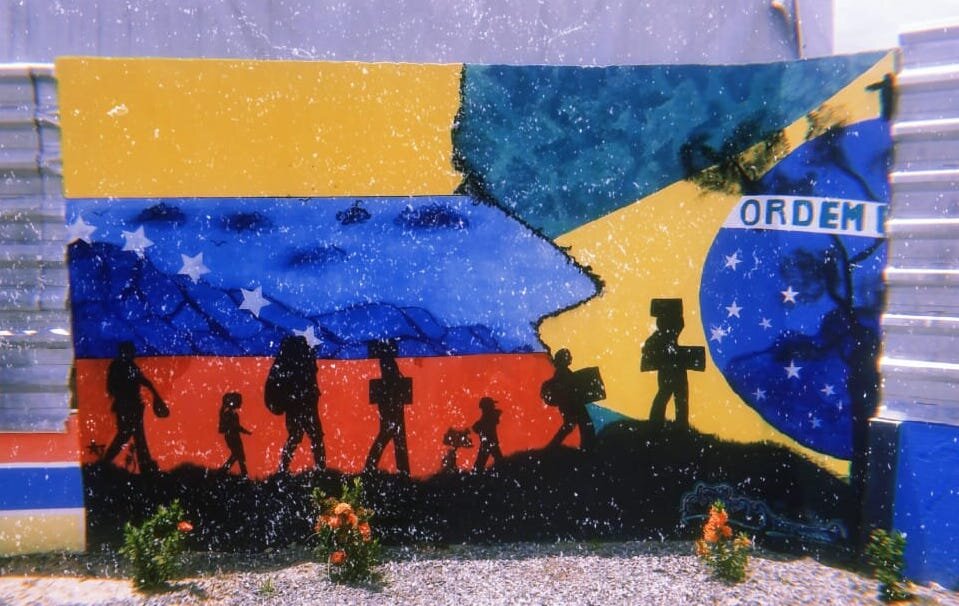Operation Welcome: A gender and climate lens to Brazil's Humanitarian Response for Venezuelan Migrants and Refugees
Picture taken by the author at one of the Refugee shelters in the area, called Rondon 3.
By Naiara Nunes, Translator at EmpoderaClima
Human Rights violations, environmental catastrophes, poor harvests, lack of access to food and drinkable water; these are just some of the many causes that can trigger human migration. For centuries, the human race moved across the globe, sometimes by will, others by force. In every migration scenario, there are adaptation challenges and more often than not, these challenges deepen existing vulnerabilities.
In South America, the Venezuelan diaspora, caused by the political and socio-economic situation in the country, generated the displacement of more than 5,490,000 Venezuelans, according to data from the Coordination Platform for Migrants and Refugees of Venezuela (R4V).
In Brazil, the fifth destination of Venezuelans, this mass migration triggered the creation of Operation Welcome (Operação Acolhida, in Portuguese), a humanitarian taskforce that combines the efforts of the Brazilian Ministry of Citizenship, the Brazilian Army, UN bodies and implementation partners such as NGOs.
This operation that aims to promote dignity for Venezuelan migrants and refugees has three main pillars: (1) The Border’s Ordination; (2) Reception; and (3) Interiorization.
This first pillar is put into action right after the Border between Brazil and Venezuela, in a military facility at the city of Pacaraima, Roraima. As soon as the Venezuelans cross the border to Brazil, they experience the first contact with this humanitarian operation. At the Reception and Identification Station (PRI) they receive water, food, medical attention, information about Brazil’s policies towards migrants and refugees and get the issuance of some documents.
The second pillar, the Reception, ensures the possibility of living in temporary shelters for those that do not have the means to get settled in Brazil right away. At these shelters, access is provided to daily meals, preparatory courses, Portuguese classes as well as the support of the implementation partners of the UN High Commissioner for Refugees (UNHCR) that work in the shelters’ management.
The third and last pillar, the Interiorization Program, aims to promote safe migration to the Venezuelans that are willing to move to other parts of Brazil. This program is completely free, and has four modalities: Shelter-to-Shelter (from the state of Roraima to other states in Brazil); Family Reunification; Social Reunification; and, by Work. You can find more information about this program here.
For Brazil, the largest country in South America, the humanitarian response for this massive migration can create the basis for the coming humanitarian responses in the climate displacement flows to come. Globally, it is understood that climate change will directly impact migratory processes, making it necessary to adopt humanitarian responses in order to safeguard fundamental rights of migrants/refugees/displaced persons.
In this sense, Brazil, as a nation that already leads a large-scale humanitarian operation within its territory, has the possibility of setting the tone of a Global South approach to climate-driven displacements. A response that does not label migrants as a threat and, moreover, that has as its core the respect to people’s dignity and their right to move.
Considering the scale of this operation, it is crucial that a gender lens is adopted, as climate migration and gender inequality go hand in hand. This issue was already analyzed in detail on EmpoderaClima's article Climate Migration: Displacements Due to the Climate Crisis Affect Women First?. Within the Operation Welcome in Brazil, there are initiatives such as ‘Empowering Refugee Women’ (Empoderando Refugiadas, in Portuguese) that provide courses and capacity-building activities for refugee women, so that they are able to access the Brazilian workforce. This initiative has groups of between thirty and fifty women, and represent a turning point for them, as they become motivated and therefore, have access to other work opportunities.
Picture taken by author in Pacaraima, Brazil's border with Venezuela
Furthermore, in 2020, UNHCR launched a study about Green Jobs that includes some lessons about Operation Welcome and also maps sectors of the green economy in Brazil. At this study, they conclude that it is currently possible to promote the insertion of migrants and refugees in green jobs through the Operation. This can only become a reality if the sector, the companies and the employers are committed to promote inclusion amongst their employers, hiring not only locals, or men, but also migrants, refugees, cis women, trans women, and persons with disability, creating a ‘plural standard’ of access to these kinds of jobs, which can impact the access to the green economy market in the future.
In a scenario in which thousands of families are displaced, with many families being led by single mothers, large-scale plans are urgent to help individuals to adapt and rebuild their lives in a new region. One of the actions we can take is demanding more inclusion, not just in the workforce, but also in politics and academia. By promoting intersectionality in humanitarian action and climate adaptation, we can create humanitarian responses that focus on people’s specific necessities and on development plans with social impact.
Two questions remain. If in the future, a climate catastrophe happens in Brazil, or in any other country in Latin America, considering the three pillars of the Welcome Operation that aim to promote dignity, provide shelter and help subjects to find new opportunities in other cities/states;
Will they be enough to tackle people’s needs in a climate crisis?
How can we improve this humanitarian response and create strategies to help people's recovery ?
The migratory processes in the globe have a secular dynamic. This dynamic will exist way after we part from this planet. We have a collective responsibility with ourselves and the ones that will come after us. Thus, we must use the time we have now to develop new ways to help in the mitigation and adaptation process to climate change, always keeping in mind the principles of intersectionality and gender and climate justice.


